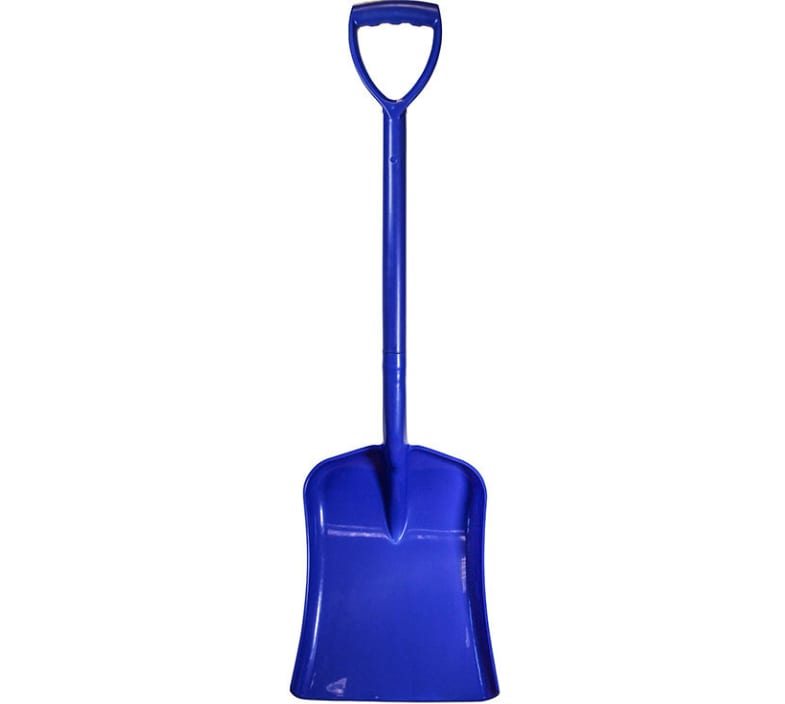Shovels & Spades
(5 Products)Shovels and spades are essential hand tools for excavation, ground preparation, and material handling across construction, landscaping, and civil engineering works. Manufactured in a variety of blade shapes and materials, they provide the mechanical leverage and durability required for digging, lifting, and transferring soil, aggregate, or other bulk materials on site.
Understanding Shovels & Spades
Shovels and spades are manually operated tools designed for the controlled excavation and movement of earth and aggregates. Though often used interchangeably, each serves distinct purposes defined by blade shape and design.
Spades typically feature a straight, flat blade suited to cutting through turf, edging, and trenching, while shovels incorporate a curved or dished blade for lifting and moving loose material.
Construction-grade models are produced from forged or pressed steel for high tensile strength, often with reinforced sockets and hardwood or tubular steel handles to withstand repeated impact loading. Modern designs may also utilise polymer or composite materials to reduce weight and resist corrosion, particularly in wet or chemical-prone environments.
The performance of shovels and spades depends on blade geometry, handle design, and material composition. A square blade provides stability and control for levelling and edging, while round-point and grafting designs allow deeper penetration into compacted soil or aggregate. Ergonomic grips and correctly balanced shafts reduce operator fatigue during continuous site use.
Material Range
- Carbon Steel Blades: Heat-treated for strength and wear resistance in general construction work.
- All-Steel Construction: Fully welded assemblies offering maximum rigidity and durability for heavy-duty digging.
- Plastic or Polymer Blades: Lightweight, corrosion-resistant options for snow or light material handling.
- Hardwood Shafts: Traditional and shock-absorbing for balanced control.
- Tubular Steel Handles: Provide high strength-to-weight ratio and long-term durability.
Key Features
- Blade Strength: Forged or pressed construction maintains edge integrity under load.
- Socket Design: Open, closed, or strapped sockets secure blade-to-handle connection.
- Corrosion Resistance: Protective coatings or polymer finishes extend service life.
- Ergonomics: D-shaped, T-grip, or straight handles improve operator comfort.
- Versatility: Suitable for soil, sand, gravel, or light demolition materials.
- Impact Resistance: Designed to absorb shock from hard ground penetration.
Typical Applications
- Groundworks: Cutting, trenching, and excavation in soil and clay substrates.
- Concrete and Aggregate Handling: Transferring ballast, sand, or mix to working areas.
- Landscaping and Turfing: Preparing beds, edging, and removing spoil.
- Road and Path Maintenance: Levelling, spreading, and compacting base layers.
- Agricultural and Utility Work: Digging post holes, drainage channels, and general maintenance.
Specification & Standards
- BS 3388: Specification for shovels and spades for general purposes.
- BS EN ISO 15601: Hand tools - general requirements for performance and safety.
- BS EN 131: Relevant sections for handle and shaft strength where applicable.
Related Materials and Construction Uses
Shovels and spades are routinely used alongside wheelbarrows, buckets, and mixing equipment in ground preparation and material handling operations.
They complement mechanical tools such as post-hole augers, compactors, and mixers, forming part of the essential manual toolkit for site preparation, concreting, and finishing.
Their use extends from small-scale groundwork to large civil infrastructure maintenance, where precision and control in confined or varied terrain are required.
Frequently Asked Shovels & Spades Questions
What Is the Difference Between a Shovel and a Spade?
A shovel typically has a curved blade and is used for digging and moving loose materials, while a spade has a flat, straight blade for cutting and edging soil or turf. Both are essential hand tools in groundworking and landscaping.
What Materials Are Shovel and Spade Blades Made From?
Blades are usually manufactured from forged or pressed carbon steel for strength and durability. Some models feature stainless steel to resist corrosion, while lightweight options use aluminium or reinforced polymer composites.
What Handle Types Are Available for Shovels and Spades?
Common handle materials include hardwood, fibreglass, and tubular steel. Handle shapes vary between straight, D-grip, and T-grip styles, selected for comfort, control, and application type.
Which Shovel Is Best for Digging Heavy Soil?
For clay or compacted ground, a round-point or square-mouth shovel with a heavy-duty carbon steel blade and reinforced socket provides better penetration and durability under load.
Are Shovels and Spades Available in Different Sizes?
Yes. Blade widths and handle lengths vary to suit general digging, trenching, or edging work. Standard lengths are typically between 900mm and 1200mm, depending on ergonomic and task requirements.
How Should a Shovel or Spade Be Maintained?
After use, clean off soil and moisture to prevent corrosion. Periodically oil wooden handles and sharpen blade edges when necessary. Store tools in a dry, covered area to extend service life.
What Standards Apply to Shovels and Spades in the UK?
Relevant standards include BS 3388 for hand tools and BS EN ISO 8442 for material specifications. Manufacturers may also comply with ergonomic and safety guidelines under EN 1005-3.
Can Shovels and Spades Be Used for Concrete or Aggregate Work?
Yes. Square-mouth shovels and taper-mouth shovels are suitable for mixing or transferring concrete, sand, and aggregates. Heavy-duty forged models are recommended for frequent or industrial use.
What Is the Difference Between a Border Spade and a Garden Spade?
A border spade has a narrower, lighter blade for precision work around plants and confined spaces, whereas a garden spade features a broader blade for general soil turning and edging tasks.
Are Ergonomic Shovels and Spades Available?
Yes. Ergonomic models include bent or extended handles to reduce strain and improve posture during repetitive digging. These designs support compliance with manual handling guidelines.





